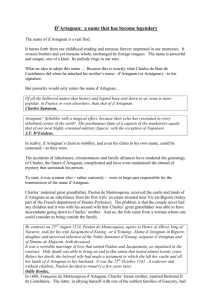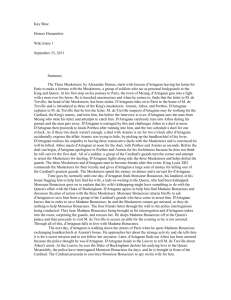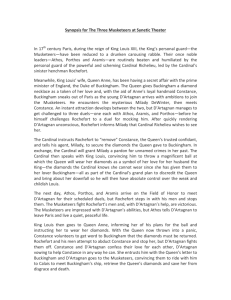- Le monde de d`Artagnan
advertisement
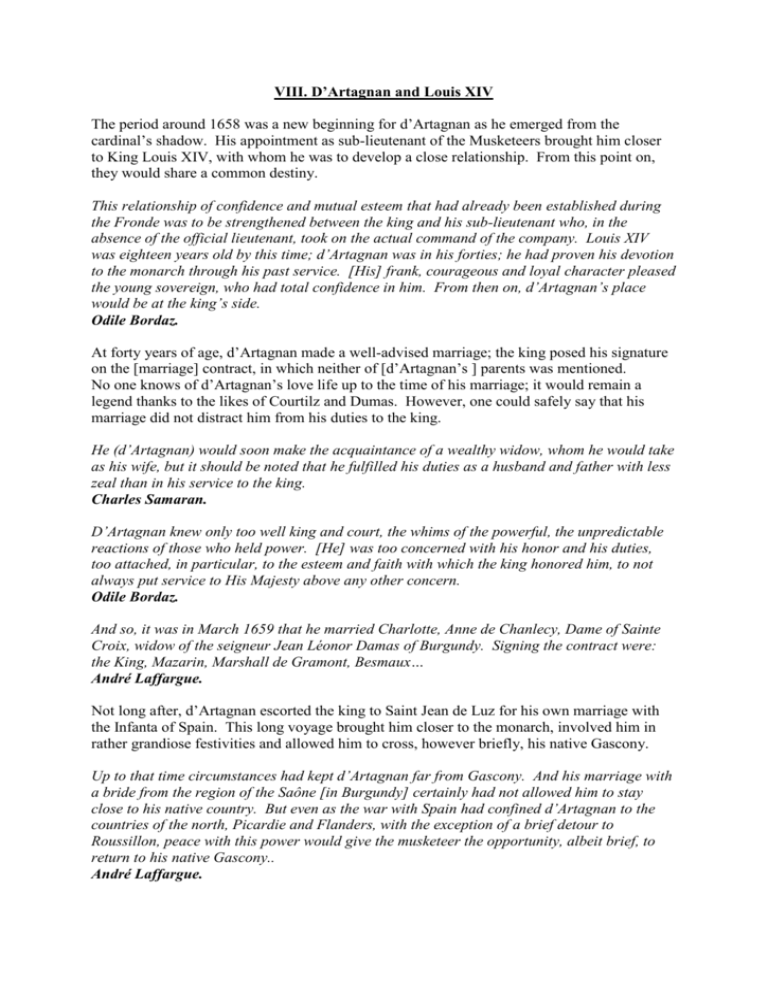
VIII. D’Artagnan and Louis XIV The period around 1658 was a new beginning for d’Artagnan as he emerged from the cardinal’s shadow. His appointment as sub-lieutenant of the Musketeers brought him closer to King Louis XIV, with whom he was to develop a close relationship. From this point on, they would share a common destiny. This relationship of confidence and mutual esteem that had already been established during the Fronde was to be strengthened between the king and his sub-lieutenant who, in the absence of the official lieutenant, took on the actual command of the company. Louis XIV was eighteen years old by this time; d’Artagnan was in his forties; he had proven his devotion to the monarch through his past service. [His] frank, courageous and loyal character pleased the young sovereign, who had total confidence in him. From then on, d’Artagnan’s place would be at the king’s side. Odile Bordaz. At forty years of age, d’Artagnan made a well-advised marriage; the king posed his signature on the [marriage] contract, in which neither of [d’Artagnan’s ] parents was mentioned. No one knows of d’Artagnan’s love life up to the time of his marriage; it would remain a legend thanks to the likes of Courtilz and Dumas. However, one could safely say that his marriage did not distract him from his duties to the king. He (d’Artagnan) would soon make the acquaintance of a wealthy widow, whom he would take as his wife, but it should be noted that he fulfilled his duties as a husband and father with less zeal than in his service to the king. Charles Samaran. D’Artagnan knew only too well king and court, the whims of the powerful, the unpredictable reactions of those who held power. [He] was too concerned with his honor and his duties, too attached, in particular, to the esteem and faith with which the king honored him, to not always put service to His Majesty above any other concern. Odile Bordaz. And so, it was in March 1659 that he married Charlotte, Anne de Chanlecy, Dame of Sainte Croix, widow of the seigneur Jean Léonor Damas of Burgundy. Signing the contract were: the King, Mazarin, Marshall de Gramont, Besmaux… André Laffargue. Not long after, d’Artagnan escorted the king to Saint Jean de Luz for his own marriage with the Infanta of Spain. This long voyage brought him closer to the monarch, involved him in rather grandiose festivities and allowed him to cross, however briefly, his native Gascony. Up to that time circumstances had kept d’Artagnan far from Gascony. And his marriage with a bride from the region of the Saône [in Burgundy] certainly had not allowed him to stay close to his native country. But even as the war with Spain had confined d’Artagnan to the countries of the north, Picardie and Flanders, with the exception of a brief detour to Roussillon, peace with this power would give the musketeer the opportunity, albeit brief, to return to his native Gascony.. André Laffargue. The Treaty of the Pyrenees was signed the 7th November 1659. Completing the treaty of Westphalia, it guaranteed France’s hegemony in Europe (…) Among the other clauses of the treaty: the marriage of Louis XIV with the Infanta Maria Theresa. Stéphane Beaumont. When he left Fontainebleau in the summer of 1659, Louis XIV expected to go directly to Saint Jean de Luz, where he was to celebrate his marriage with the Infanta Maria Theresa (…) The slowness of diplomacy, the late departure of the Spanish court from Madrid, due to the poor health of King Philip IV, prolonged the duration of the journey considerably. D’Artagnan, at the head of the company of the musketeers, had the mission of escorting the king and his family during the journey. A long, one-year voyage across the provinces of the south commenced for them, an excellent occasion for the young Louis XIV to discover his kingdom and show himself to his people. Odile Bordaz. On the 23rd of April 1660, the royal cortege, coming from Toulouse, passed by Isle-Jourdain; the next day, they were at Auch. On the 25th, still following the road from Toulouse to Bayonne, the King and the Queen Mother entered Vic-Fezensac at around four o’clock in the afternoon (…) Everyone retired for the night at Vic or in the surrounding castles, and the consuls’ reports did not fail to mention that Their Majesties were escorted by the company of musketeers and that Monsieur d’Artagnan, “it’s lieutenant, who was commanding, mounted a routine guard.” Charles Samaran. Louis XIV lodged in the home of the nobleman Descomps, a sixteenth century manor situated next to the church of Saint Pierre and one of the four gates leading into the town’s center. Vic was a typical Gascon town with its four-cornered central square surrounded by arcades, a covered market dating from the fifteenth century in its center. On this Sunday evening on the 25th April 1660, the ambiance was festive. The king of France and his court were staying within the walls of Vic. Odile Bordaz. The next day, the Court set out for Nogaro, by way of Dému and Manciet. The route passed within one league of Castelmore. Was d’Artagnan tempted to gallop off to pay his respects at the tomb of his mother, who had died four years earlier, the 20th September 1656, and who was resting in the family chapel of Beaubeste? (…) No one knows. Whatever the case may be, this too-short breath of native air must have been moving for this son of Gascony, away for more than twenty years, and who would never see his parents’ tombs again. Andreé Laffargue. For d’Artagnan there was probably no sweeter memory than that of this slow and fairy-like journey across his old, native Gascony, which he had probably not seen in nearly thirty years. Jean-Christian Petitfils. And so they continued their journey, the most splendid trek of their entire lives, crossing these countries of Gascony, Béarn, Navarre, where stood the family manors of Lanne, Espalunge et many others! Thus, they entered Saint Jean de Luz (…) Trumpets sounded. The good people shouted and cried with joy. One advanced in the old, darkened streets, paved with precious carpets and strewn with flowers as for a [religious] procession of Corpus Domini. No monarch had ever known such joys. In this step-by-step journey across his kingdom, Louis XIV, married with France in Reims, finally took carnal possession of the land and the nation that had offered themselves to him. Armand Praviel. The peace treaty between France and Spain was ratified on 6th June 1660. Louis XIV and Philip IV swore on the Gospels to “respect all that was contained in this treaty”. D’Artagnan and his Company of Musketeers, mounted on their white horses, attired in their most beautiful and bedecked uniforms –azure tunics with the cross of gold and silver in the form of the fleurde-lis—lent to the event this esthetic symbolism that history, during that century as during others, had always demanded. One could find standing side-by-side with the Musketeers the Swiss Guards in their blues tunics, the French Guards of Marshall Gramont, gendarmes and light-horses. Stéphane Beaumont. Of all the ceremonies, that of the wedding, on Wednesday, 9th June 1660, would surpass in magnificence all that one could imagine. According to witnesses, this was the wedding of fairy tales, a ceremony of pomp in the purest baroque style. Odile Bordaz. D’Artagnan and his companions had been the witnesses to the first celebrations of the new Court; they had participated with wonder in the splendors of the Coronation in Reims, persuaded that they were witnessing the dawn of a great reign. [But] they had never experienced anything more moving nor more grandiose than the royal wedding ceremonies in Saint Jean de Luz. Jean-Christian Petitfils. The royal couple’s triumphant return to Paris marked the beginning of a new era for France. From this point on, the people found new faith in their leaders. Mazarin could finally retire and die in peace. The king held absolute power and, with d’Artagnan at his side, he had a faithful servant whom he could rely on. Two months later, d’Artagnan had another opportunity to shine in one of the most majestic deployments of pomp and circumstance that the people of Paris had ever had the good fortune to gaze upon. The young royal couple, having left Saint Jean de Luz the 15th June 1660, had arrived at Fontainebleau exactly one month later. The only thing missing was the solemn entry, during which the king would present Maria Theresa to his capital. This ceremony took place the 26th August. Charles Samaran. The triumphant entry into the city of Paris of Their Majesties Louis XIV King of France and Navarre and his wife Maria Theresa on Thursday, 26th August 1660 remains in the annals as an exceptional event. D’Artagnan and the musketeers in particular attracted the attention and the applause of the crowd lining the parade route which, in the space of four hours, led the cortege from Saint Antoine’s Gate to the Louvre. Odile Bordaz. D’Artagnan leads the cavalcade with a proud and tranquil assurance. The years of difficulty, today crowned in victory, have absorbed his best years, the prime of his life. Struggle against those damned Spanish, their rascally neighbors from down south, from whom we had managed to take away their provinces and ravish their Infanta; struggle against those great seigneurs, now all rallied, tamed and trembling, ready to champion the reign of Louis XIV; struggle against the Parliament, now full of harangues and deferential smiles; against this bourgeoisie and this populace shouting at the top of their lungs: Long live the King! Armand Praviel. A man leaning discretely from the balcony of Beauvais Hall must have savored this triumphant entry of the young king more than anyone else, because it constituted the apotheosis of his life’s work. But who would have recognized this tired old man, racked and bent from gout and kidney stones? He wasn’t yet sixty, but the accumulated fatigue from the civil war made him appear ten or fifteen years older(…) A few months later, on the 9th March 1661, he was able to die in peace, satisfied at having faithfully served his country of adoption but without –oh, no!—neglecting his own personal interests. Jean-Chrisitan Petitfils. D’Artagnan had just experienced great moments in the king’s presence. This tour of France had in fact made him more than a traditional musketeer, more than just an escort leader or chief of “royal security”. He had become, for this monarch of 22 years of age, facing with determination the loneliness that comes with power after the death of Mazarin, during the night of 8th to 9th March 1661, one of his most trusted right-hand men, to whom one could give the most important missions, including those concerning the interests of the State. Stéphane Beaumont.
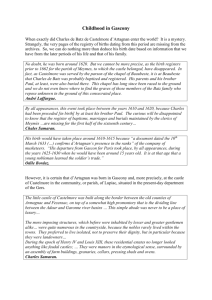
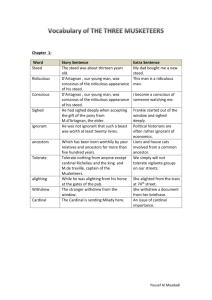
![Pre20thCenturyBookReport[1]](http://s3.studylib.net/store/data/009667422_1-2f891bee829714ddeceef4d4dc4edde6-300x300.png)

